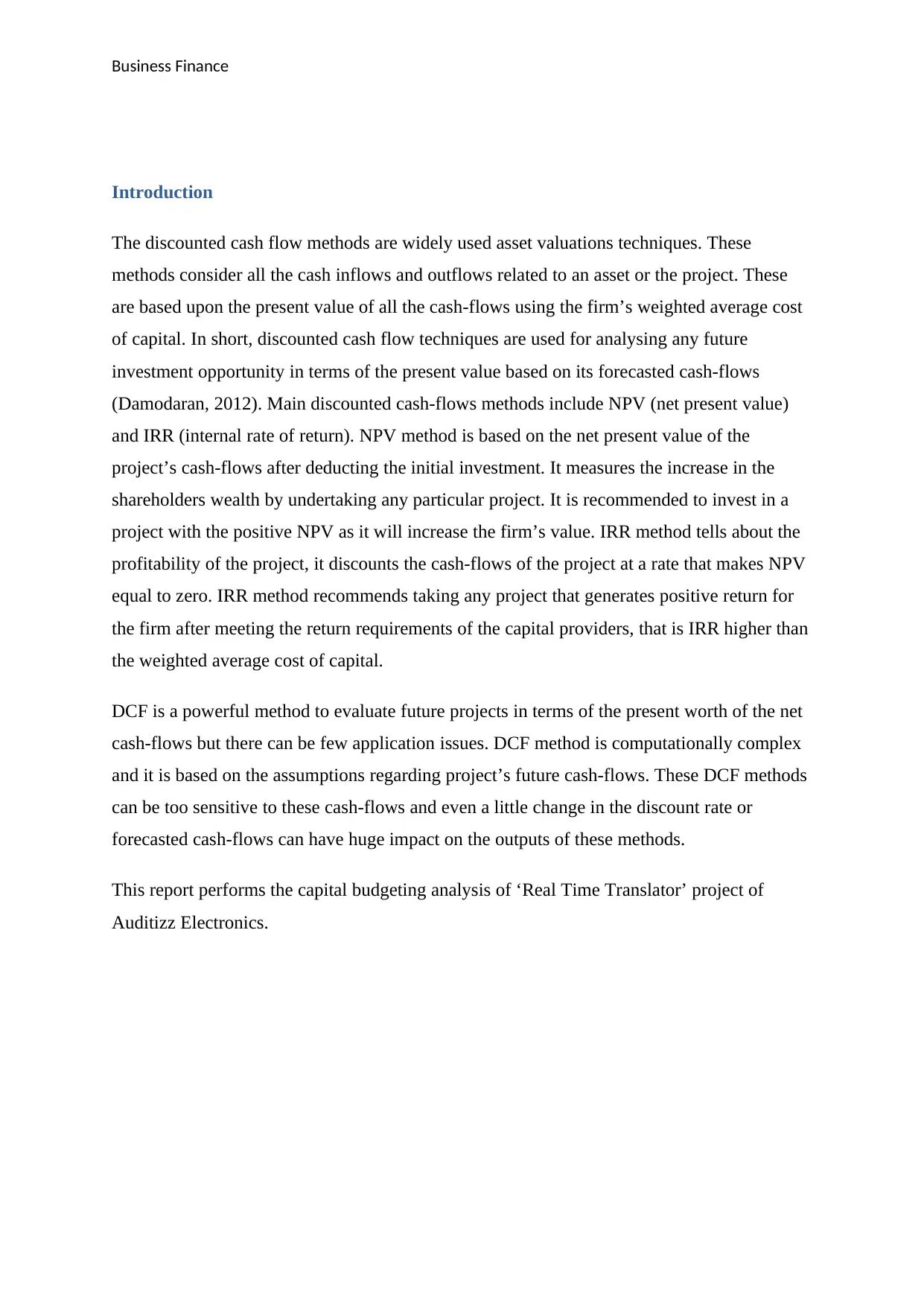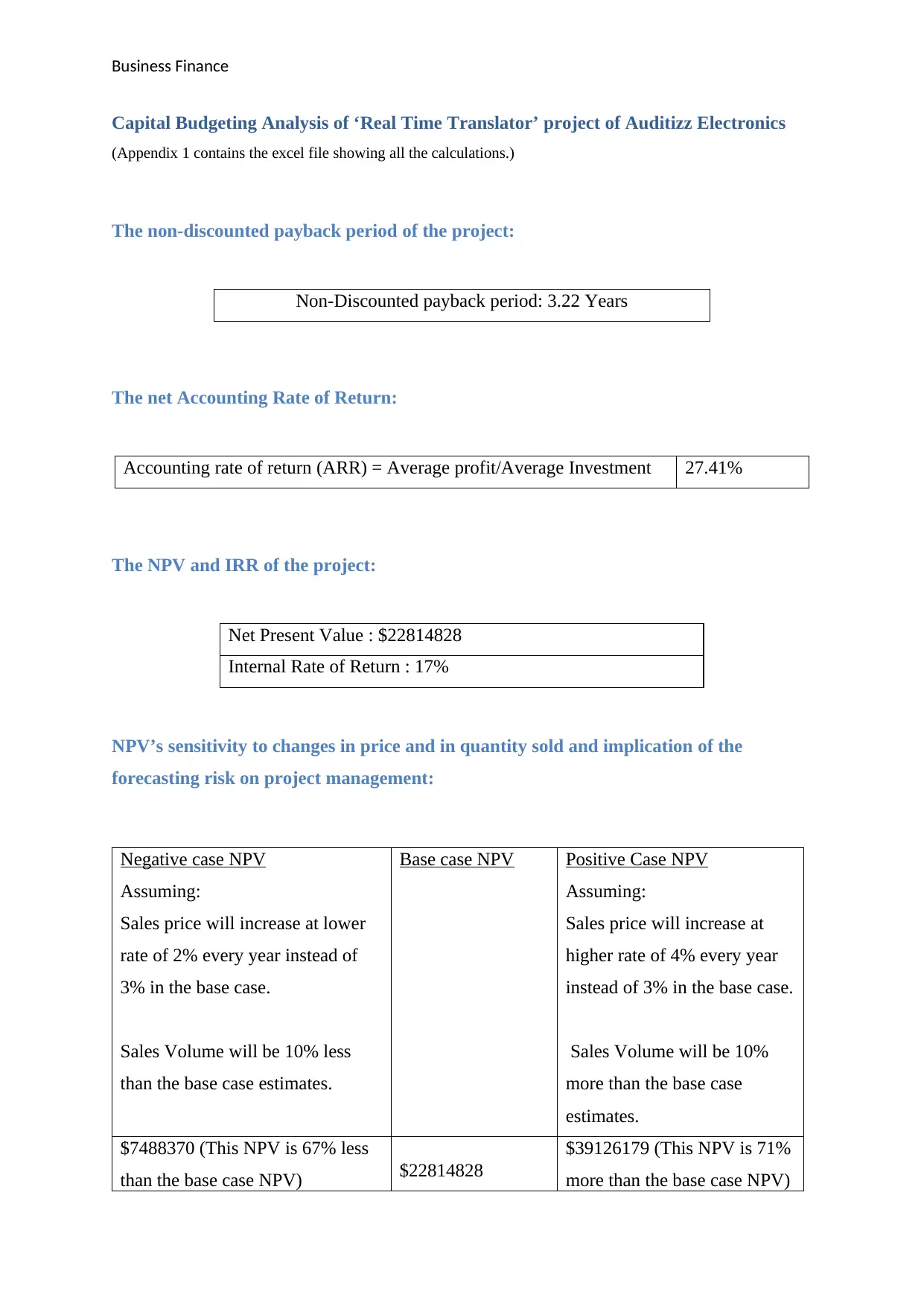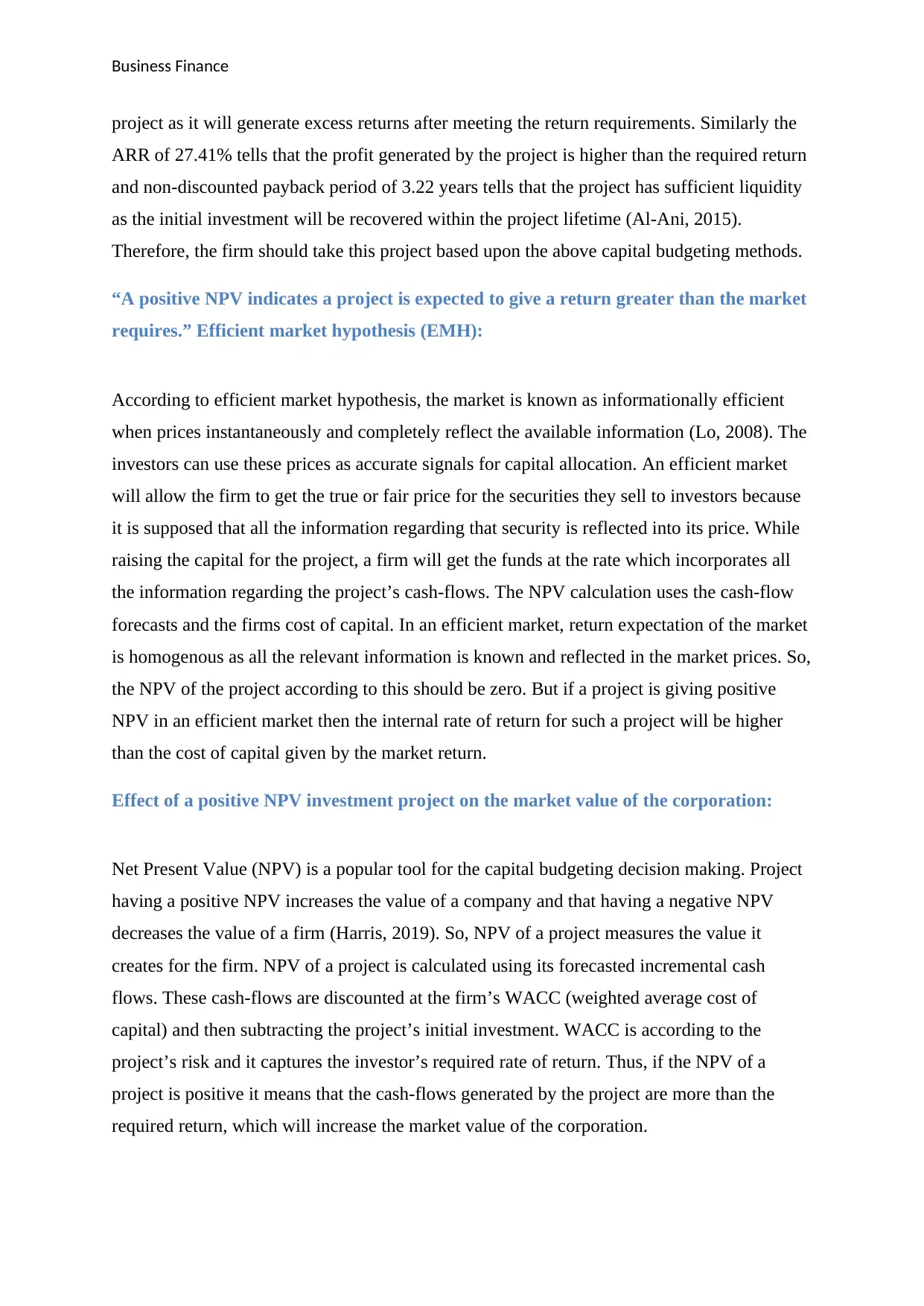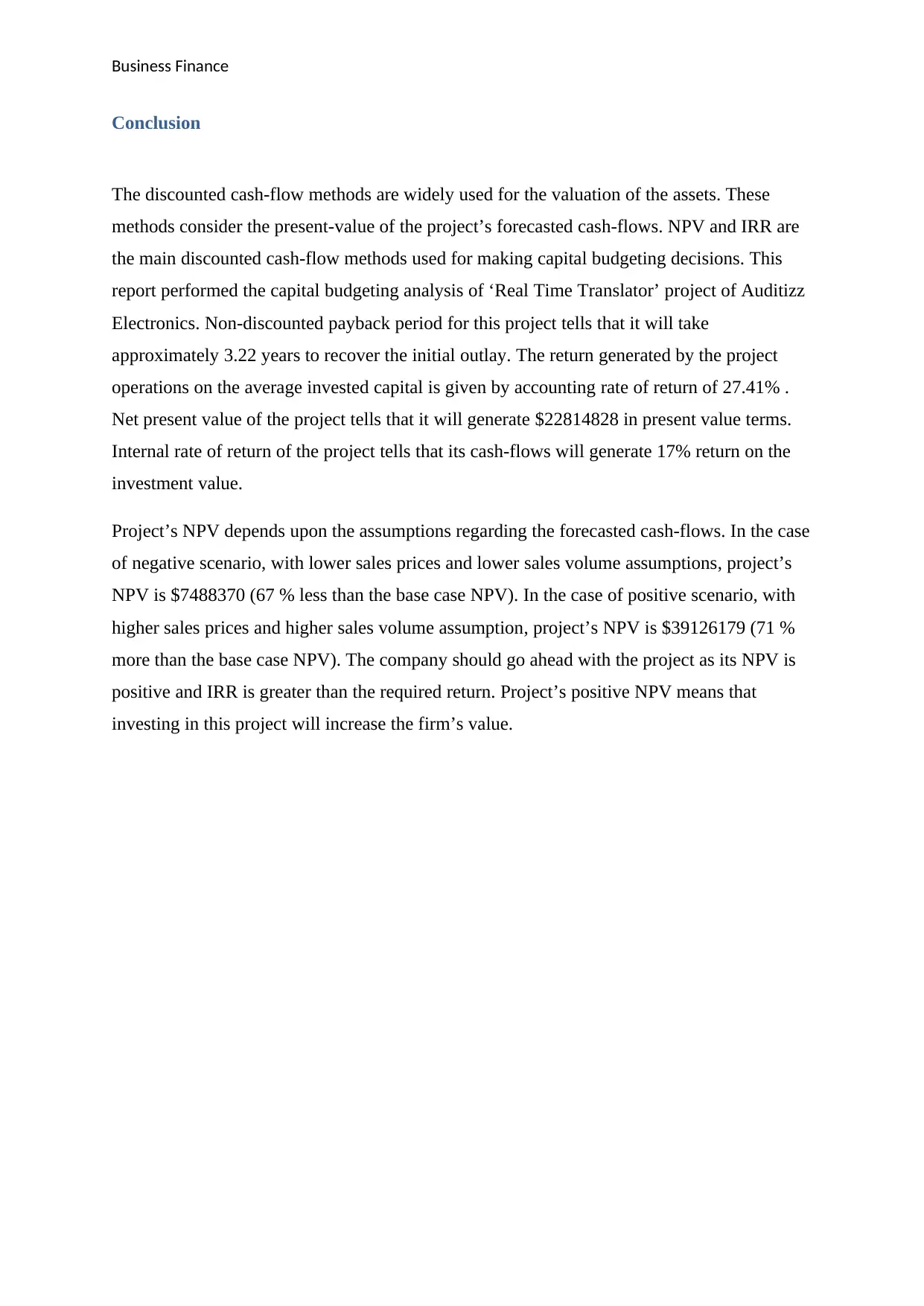ACC211 Business Finance Report on Auditizz Electronics Project
VerifiedAdded on 2023/03/20
|10
|2053
|64
Report
AI Summary
This report provides a comprehensive capital budgeting analysis of the 'Real Time Translator' project undertaken by Auditizz Electronics. It utilizes discounted cash flow (DCF) methods, including Net Present Value (NPV) and Internal Rate of Return (IRR), to evaluate the project's financial viability. The report calculates the non-discounted payback period, accounting rate of return (ARR), NPV, and IRR, along with sensitivity analyses to changes in sales price and volume. It also discusses the efficient market hypothesis (EMH) and the impact of a positive NPV on the corporation's market value. The analysis concludes with an investment decision based on the project's positive NPV and IRR, recommending the project's acceptance. The report highlights the importance of considering forecasting risks and the implications for project management, emphasizing the need for sensitivity analysis to ensure optimal resource allocation and firm value maximization.

Running Head: Business Finance
Business Finance
Report project task
Student Name
Business Finance
Report project task
Student Name
Paraphrase This Document
Need a fresh take? Get an instant paraphrase of this document with our AI Paraphraser

Business Finance
Contents
Introduction...........................................................................................................................................2
Capital Budgeting Analysis of ‘Real Time Translator’ project of Auditizz Electronics........................3
The non-discounted payback period of the project:...........................................................................3
The net Accounting Rate of Return:..................................................................................................3
The NPV and IRR of the project:......................................................................................................3
NPV’s sensitivity to changes in price and in quantity sold and implication of the forecasting risk on
project management:..........................................................................................................................4
Investment decision:..........................................................................................................................5
“A positive NPV indicates a project is expected to give a return greater than the market requires.”
Efficient market hypothesis (EMH):..................................................................................................5
Effect of a positive NPV investment project on the market value of the corporation:.......................6
Conclusion.............................................................................................................................................7
References.............................................................................................................................................8
Appendix:..............................................................................................................................................9
Contents
Introduction...........................................................................................................................................2
Capital Budgeting Analysis of ‘Real Time Translator’ project of Auditizz Electronics........................3
The non-discounted payback period of the project:...........................................................................3
The net Accounting Rate of Return:..................................................................................................3
The NPV and IRR of the project:......................................................................................................3
NPV’s sensitivity to changes in price and in quantity sold and implication of the forecasting risk on
project management:..........................................................................................................................4
Investment decision:..........................................................................................................................5
“A positive NPV indicates a project is expected to give a return greater than the market requires.”
Efficient market hypothesis (EMH):..................................................................................................5
Effect of a positive NPV investment project on the market value of the corporation:.......................6
Conclusion.............................................................................................................................................7
References.............................................................................................................................................8
Appendix:..............................................................................................................................................9

Business Finance
Introduction
The discounted cash flow methods are widely used asset valuations techniques. These
methods consider all the cash inflows and outflows related to an asset or the project. These
are based upon the present value of all the cash-flows using the firm’s weighted average cost
of capital. In short, discounted cash flow techniques are used for analysing any future
investment opportunity in terms of the present value based on its forecasted cash-flows
(Damodaran, 2012). Main discounted cash-flows methods include NPV (net present value)
and IRR (internal rate of return). NPV method is based on the net present value of the
project’s cash-flows after deducting the initial investment. It measures the increase in the
shareholders wealth by undertaking any particular project. It is recommended to invest in a
project with the positive NPV as it will increase the firm’s value. IRR method tells about the
profitability of the project, it discounts the cash-flows of the project at a rate that makes NPV
equal to zero. IRR method recommends taking any project that generates positive return for
the firm after meeting the return requirements of the capital providers, that is IRR higher than
the weighted average cost of capital.
DCF is a powerful method to evaluate future projects in terms of the present worth of the net
cash-flows but there can be few application issues. DCF method is computationally complex
and it is based on the assumptions regarding project’s future cash-flows. These DCF methods
can be too sensitive to these cash-flows and even a little change in the discount rate or
forecasted cash-flows can have huge impact on the outputs of these methods.
This report performs the capital budgeting analysis of ‘Real Time Translator’ project of
Auditizz Electronics.
Introduction
The discounted cash flow methods are widely used asset valuations techniques. These
methods consider all the cash inflows and outflows related to an asset or the project. These
are based upon the present value of all the cash-flows using the firm’s weighted average cost
of capital. In short, discounted cash flow techniques are used for analysing any future
investment opportunity in terms of the present value based on its forecasted cash-flows
(Damodaran, 2012). Main discounted cash-flows methods include NPV (net present value)
and IRR (internal rate of return). NPV method is based on the net present value of the
project’s cash-flows after deducting the initial investment. It measures the increase in the
shareholders wealth by undertaking any particular project. It is recommended to invest in a
project with the positive NPV as it will increase the firm’s value. IRR method tells about the
profitability of the project, it discounts the cash-flows of the project at a rate that makes NPV
equal to zero. IRR method recommends taking any project that generates positive return for
the firm after meeting the return requirements of the capital providers, that is IRR higher than
the weighted average cost of capital.
DCF is a powerful method to evaluate future projects in terms of the present worth of the net
cash-flows but there can be few application issues. DCF method is computationally complex
and it is based on the assumptions regarding project’s future cash-flows. These DCF methods
can be too sensitive to these cash-flows and even a little change in the discount rate or
forecasted cash-flows can have huge impact on the outputs of these methods.
This report performs the capital budgeting analysis of ‘Real Time Translator’ project of
Auditizz Electronics.
⊘ This is a preview!⊘
Do you want full access?
Subscribe today to unlock all pages.

Trusted by 1+ million students worldwide

Business Finance
Capital Budgeting Analysis of ‘Real Time Translator’ project of Auditizz Electronics
(Appendix 1 contains the excel file showing all the calculations.)
The non-discounted payback period of the project:
Non-Discounted payback period: 3.22 Years
The net Accounting Rate of Return:
Accounting rate of return (ARR) = Average profit/Average Investment 27.41%
The NPV and IRR of the project:
Net Present Value : $22814828
Internal Rate of Return : 17%
NPV’s sensitivity to changes in price and in quantity sold and implication of the
forecasting risk on project management:
Negative case NPV
Assuming:
Sales price will increase at lower
rate of 2% every year instead of
3% in the base case.
Sales Volume will be 10% less
than the base case estimates.
Base case NPV Positive Case NPV
Assuming:
Sales price will increase at
higher rate of 4% every year
instead of 3% in the base case.
Sales Volume will be 10%
more than the base case
estimates.
$7488370 (This NPV is 67% less
than the base case NPV) $22814828
$39126179 (This NPV is 71%
more than the base case NPV)
Capital Budgeting Analysis of ‘Real Time Translator’ project of Auditizz Electronics
(Appendix 1 contains the excel file showing all the calculations.)
The non-discounted payback period of the project:
Non-Discounted payback period: 3.22 Years
The net Accounting Rate of Return:
Accounting rate of return (ARR) = Average profit/Average Investment 27.41%
The NPV and IRR of the project:
Net Present Value : $22814828
Internal Rate of Return : 17%
NPV’s sensitivity to changes in price and in quantity sold and implication of the
forecasting risk on project management:
Negative case NPV
Assuming:
Sales price will increase at lower
rate of 2% every year instead of
3% in the base case.
Sales Volume will be 10% less
than the base case estimates.
Base case NPV Positive Case NPV
Assuming:
Sales price will increase at
higher rate of 4% every year
instead of 3% in the base case.
Sales Volume will be 10%
more than the base case
estimates.
$7488370 (This NPV is 67% less
than the base case NPV) $22814828
$39126179 (This NPV is 71%
more than the base case NPV)
Paraphrase This Document
Need a fresh take? Get an instant paraphrase of this document with our AI Paraphraser

Business Finance
This shows that the project NPV is very sensitive to the changes in the sales price and sales
volume as just a small change in these values results in a significant change in NPV’s value.
Source: FP&A Trends (2018).
Forecasting risk is the risk arising from the uncertainties in business environment or other
factors that can affect the cash-flows of the project. Such kind of risks are major concern for
the capital budgeting methods like discounted cash-flows methods (NPV) as these methods
are very sensitive to the future forecasts. So, a failure to acknowledge forecasting risks can
derail the achievement of the investment goals as such risks can lead to unexpected future
cash flow that may results in loss-making capital investments (Stretch, 2018).
The project managers should be aware of such uncertainties and risks involved in the forecast
of project’s cash-flows. They should do the sensitivity analysis of their capital budgeting
decisions by considering different scenarios for key assumptions to notice their effect on the
projects cash-flows and the resulting capital budgeting methods (Adams, n.d.). This can help
managers to understand the forecasting risks associated with the capital budgeting process
and to find the main reasons for it. This will allow the optimal allocation of resources by the
management to increase the firm’s value.
Investment decision:
NPV for the project is a positive number ($22814828). So, this project will increase firm’s
wealth and according to the NPV rule the firm should go ahead with this project. IRR for the
project is 17%, which is greater than its required return of 11% and the firm should take this
This shows that the project NPV is very sensitive to the changes in the sales price and sales
volume as just a small change in these values results in a significant change in NPV’s value.
Source: FP&A Trends (2018).
Forecasting risk is the risk arising from the uncertainties in business environment or other
factors that can affect the cash-flows of the project. Such kind of risks are major concern for
the capital budgeting methods like discounted cash-flows methods (NPV) as these methods
are very sensitive to the future forecasts. So, a failure to acknowledge forecasting risks can
derail the achievement of the investment goals as such risks can lead to unexpected future
cash flow that may results in loss-making capital investments (Stretch, 2018).
The project managers should be aware of such uncertainties and risks involved in the forecast
of project’s cash-flows. They should do the sensitivity analysis of their capital budgeting
decisions by considering different scenarios for key assumptions to notice their effect on the
projects cash-flows and the resulting capital budgeting methods (Adams, n.d.). This can help
managers to understand the forecasting risks associated with the capital budgeting process
and to find the main reasons for it. This will allow the optimal allocation of resources by the
management to increase the firm’s value.
Investment decision:
NPV for the project is a positive number ($22814828). So, this project will increase firm’s
wealth and according to the NPV rule the firm should go ahead with this project. IRR for the
project is 17%, which is greater than its required return of 11% and the firm should take this

Business Finance
project as it will generate excess returns after meeting the return requirements. Similarly the
ARR of 27.41% tells that the profit generated by the project is higher than the required return
and non-discounted payback period of 3.22 years tells that the project has sufficient liquidity
as the initial investment will be recovered within the project lifetime (Al-Ani, 2015).
Therefore, the firm should take this project based upon the above capital budgeting methods.
“A positive NPV indicates a project is expected to give a return greater than the market
requires.” Efficient market hypothesis (EMH):
According to efficient market hypothesis, the market is known as informationally efficient
when prices instantaneously and completely reflect the available information (Lo, 2008). The
investors can use these prices as accurate signals for capital allocation. An efficient market
will allow the firm to get the true or fair price for the securities they sell to investors because
it is supposed that all the information regarding that security is reflected into its price. While
raising the capital for the project, a firm will get the funds at the rate which incorporates all
the information regarding the project’s cash-flows. The NPV calculation uses the cash-flow
forecasts and the firms cost of capital. In an efficient market, return expectation of the market
is homogenous as all the relevant information is known and reflected in the market prices. So,
the NPV of the project according to this should be zero. But if a project is giving positive
NPV in an efficient market then the internal rate of return for such a project will be higher
than the cost of capital given by the market return.
Effect of a positive NPV investment project on the market value of the corporation:
Net Present Value (NPV) is a popular tool for the capital budgeting decision making. Project
having a positive NPV increases the value of a company and that having a negative NPV
decreases the value of a firm (Harris, 2019). So, NPV of a project measures the value it
creates for the firm. NPV of a project is calculated using its forecasted incremental cash
flows. These cash-flows are discounted at the firm’s WACC (weighted average cost of
capital) and then subtracting the project’s initial investment. WACC is according to the
project’s risk and it captures the investor’s required rate of return. Thus, if the NPV of a
project is positive it means that the cash-flows generated by the project are more than the
required return, which will increase the market value of the corporation.
project as it will generate excess returns after meeting the return requirements. Similarly the
ARR of 27.41% tells that the profit generated by the project is higher than the required return
and non-discounted payback period of 3.22 years tells that the project has sufficient liquidity
as the initial investment will be recovered within the project lifetime (Al-Ani, 2015).
Therefore, the firm should take this project based upon the above capital budgeting methods.
“A positive NPV indicates a project is expected to give a return greater than the market
requires.” Efficient market hypothesis (EMH):
According to efficient market hypothesis, the market is known as informationally efficient
when prices instantaneously and completely reflect the available information (Lo, 2008). The
investors can use these prices as accurate signals for capital allocation. An efficient market
will allow the firm to get the true or fair price for the securities they sell to investors because
it is supposed that all the information regarding that security is reflected into its price. While
raising the capital for the project, a firm will get the funds at the rate which incorporates all
the information regarding the project’s cash-flows. The NPV calculation uses the cash-flow
forecasts and the firms cost of capital. In an efficient market, return expectation of the market
is homogenous as all the relevant information is known and reflected in the market prices. So,
the NPV of the project according to this should be zero. But if a project is giving positive
NPV in an efficient market then the internal rate of return for such a project will be higher
than the cost of capital given by the market return.
Effect of a positive NPV investment project on the market value of the corporation:
Net Present Value (NPV) is a popular tool for the capital budgeting decision making. Project
having a positive NPV increases the value of a company and that having a negative NPV
decreases the value of a firm (Harris, 2019). So, NPV of a project measures the value it
creates for the firm. NPV of a project is calculated using its forecasted incremental cash
flows. These cash-flows are discounted at the firm’s WACC (weighted average cost of
capital) and then subtracting the project’s initial investment. WACC is according to the
project’s risk and it captures the investor’s required rate of return. Thus, if the NPV of a
project is positive it means that the cash-flows generated by the project are more than the
required return, which will increase the market value of the corporation.
⊘ This is a preview!⊘
Do you want full access?
Subscribe today to unlock all pages.

Trusted by 1+ million students worldwide

Business Finance
Conclusion
The discounted cash-flow methods are widely used for the valuation of the assets. These
methods consider the present-value of the project’s forecasted cash-flows. NPV and IRR are
the main discounted cash-flow methods used for making capital budgeting decisions. This
report performed the capital budgeting analysis of ‘Real Time Translator’ project of Auditizz
Electronics. Non-discounted payback period for this project tells that it will take
approximately 3.22 years to recover the initial outlay. The return generated by the project
operations on the average invested capital is given by accounting rate of return of 27.41% .
Net present value of the project tells that it will generate $22814828 in present value terms.
Internal rate of return of the project tells that its cash-flows will generate 17% return on the
investment value.
Project’s NPV depends upon the assumptions regarding the forecasted cash-flows. In the case
of negative scenario, with lower sales prices and lower sales volume assumptions, project’s
NPV is $7488370 (67 % less than the base case NPV). In the case of positive scenario, with
higher sales prices and higher sales volume assumption, project’s NPV is $39126179 (71 %
more than the base case NPV). The company should go ahead with the project as its NPV is
positive and IRR is greater than the required return. Project’s positive NPV means that
investing in this project will increase the firm’s value.
Conclusion
The discounted cash-flow methods are widely used for the valuation of the assets. These
methods consider the present-value of the project’s forecasted cash-flows. NPV and IRR are
the main discounted cash-flow methods used for making capital budgeting decisions. This
report performed the capital budgeting analysis of ‘Real Time Translator’ project of Auditizz
Electronics. Non-discounted payback period for this project tells that it will take
approximately 3.22 years to recover the initial outlay. The return generated by the project
operations on the average invested capital is given by accounting rate of return of 27.41% .
Net present value of the project tells that it will generate $22814828 in present value terms.
Internal rate of return of the project tells that its cash-flows will generate 17% return on the
investment value.
Project’s NPV depends upon the assumptions regarding the forecasted cash-flows. In the case
of negative scenario, with lower sales prices and lower sales volume assumptions, project’s
NPV is $7488370 (67 % less than the base case NPV). In the case of positive scenario, with
higher sales prices and higher sales volume assumption, project’s NPV is $39126179 (71 %
more than the base case NPV). The company should go ahead with the project as its NPV is
positive and IRR is greater than the required return. Project’s positive NPV means that
investing in this project will increase the firm’s value.
Paraphrase This Document
Need a fresh take? Get an instant paraphrase of this document with our AI Paraphraser

Business Finance
References
Adams, D. (n.d.). The Best Ways to Incorporate Risk Into Capital Budgeting [Online]. Chron.
Available from: https://smallbusiness.chron.com/ways-incorporate-risk-capital-budgeting-
15317.html [Accessed 15 May 2019].
Al-Ani, M. K. (2015). A Strategic Framework to Use Payback Period in Evaluating the
Capital Budgeting in Energy and Oil and Gas Sectors in Oman. International Journal of
Economics and Financial Issues. 5(2). pp. 469-475. Available from:
https://www.google.com/url?
sa=t&rct=j&q=&esrc=s&source=web&cd=1&ved=2ahUKEwiO1_adp5_iAhWTdn0KHWcC
BD8QFjAAegQIABAC&url=https%3A%2F%2Fwww.econjournals.com%2Findex.php
%2Fijefi%2Farticle%2Fdownload
%2F1127%2Fpdf&usg=AOvVaw2WheiwjSp7RN59qn8NI9Zc [Accessed 15 May 2019].
Damodaran, A. (2012). Investment Valuation. 3rd ed. New York: John Wiley & Sons Inc.
FP&A Trends. (2018). Forecast Risk Image [Online]. Available from: https://www.fpa-
trends.com/sites/default/files/imgorg/2016/169/forecast-risk-1.gif [Accessed 15 May 2019].
Harris, R. (2019). Value Creation, Net Present Value and Economic Profit [Online].
Available from:
https://www.researchgate.net/publication/228180330_Value_Creation_Net_Present_Value_a
nd_Economic_Profit [Accessed 15 May 2019].
Lo, A.W. (2008). Efficient Markets Hypothesis. Durlauf, S.N. and Blume L.E. (eds). The
New Palgrave Dictionary of Economics. London. Available from:
https://link.springer.com/content/pdf/10.1057/978-1-349-95121-5_42-2.pdf [Accessed 15
May 2019].
Stretch, J. (2018). How to Manage Forecasting Risk? [Online]. FP&A Trends. Available
from: https://www.fpa-trends.com/article/how-manage-forecasting-risk [Accessed 15 May
2019].
References
Adams, D. (n.d.). The Best Ways to Incorporate Risk Into Capital Budgeting [Online]. Chron.
Available from: https://smallbusiness.chron.com/ways-incorporate-risk-capital-budgeting-
15317.html [Accessed 15 May 2019].
Al-Ani, M. K. (2015). A Strategic Framework to Use Payback Period in Evaluating the
Capital Budgeting in Energy and Oil and Gas Sectors in Oman. International Journal of
Economics and Financial Issues. 5(2). pp. 469-475. Available from:
https://www.google.com/url?
sa=t&rct=j&q=&esrc=s&source=web&cd=1&ved=2ahUKEwiO1_adp5_iAhWTdn0KHWcC
BD8QFjAAegQIABAC&url=https%3A%2F%2Fwww.econjournals.com%2Findex.php
%2Fijefi%2Farticle%2Fdownload
%2F1127%2Fpdf&usg=AOvVaw2WheiwjSp7RN59qn8NI9Zc [Accessed 15 May 2019].
Damodaran, A. (2012). Investment Valuation. 3rd ed. New York: John Wiley & Sons Inc.
FP&A Trends. (2018). Forecast Risk Image [Online]. Available from: https://www.fpa-
trends.com/sites/default/files/imgorg/2016/169/forecast-risk-1.gif [Accessed 15 May 2019].
Harris, R. (2019). Value Creation, Net Present Value and Economic Profit [Online].
Available from:
https://www.researchgate.net/publication/228180330_Value_Creation_Net_Present_Value_a
nd_Economic_Profit [Accessed 15 May 2019].
Lo, A.W. (2008). Efficient Markets Hypothesis. Durlauf, S.N. and Blume L.E. (eds). The
New Palgrave Dictionary of Economics. London. Available from:
https://link.springer.com/content/pdf/10.1057/978-1-349-95121-5_42-2.pdf [Accessed 15
May 2019].
Stretch, J. (2018). How to Manage Forecasting Risk? [Online]. FP&A Trends. Available
from: https://www.fpa-trends.com/article/how-manage-forecasting-risk [Accessed 15 May
2019].

Business Finance
Appendix:
Appendix:
⊘ This is a preview!⊘
Do you want full access?
Subscribe today to unlock all pages.

Trusted by 1+ million students worldwide

Business Finance
1 out of 10
Related Documents
Your All-in-One AI-Powered Toolkit for Academic Success.
+13062052269
info@desklib.com
Available 24*7 on WhatsApp / Email
![[object Object]](/_next/static/media/star-bottom.7253800d.svg)
Unlock your academic potential
Copyright © 2020–2026 A2Z Services. All Rights Reserved. Developed and managed by ZUCOL.





